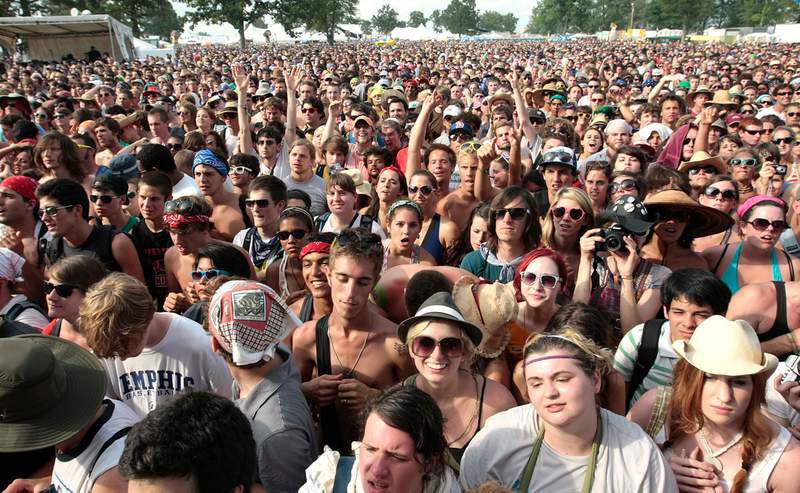Woodstocks legacy still reverberates across festival circuit
Published 5:00 am Saturday, August 15, 2009

- Fans gather in June for the Bonnaroo Arts and Music Festival, an event modeled after Woodstock, in Manchester, Tenn.
NEW YORK Todays robust festival culture owes much to Woodstock lessons from both its incredible success and its logistical nightmares.
It stands out in everybodys mind as the originator, said Michele Scoleri, artistic director of Bumbershoot, the annual Seattle festival that will draw tens of thousands Labor Day weekend for its 39th annual fest.
Giant rock festivals fan out every summer with ambitions for just a fraction of the impact of Woodstock, which began 40 years ago on Aug. 15. They are more efficiently run, more organized and dont need warnings to avoid the brown acid.
The promoters of Woodstock Michael Lang, Joel Rosenman, John Roberts and Artie Kornfeld hoped their frantic, last-minute efforts would be enough to pull off what today would take a year to prepare. The concert which drew more than 400,000 to Bethel, N.Y., Aug. 15-18, 1969 did come off, though its many problems (the miles-long traffic, the rain, the lack of food and water) only enhanced its mythology.
In his recent memoir, The Road to Woodstock, Lang writes: From the beginning, I believed that if we did our job right and from the heart, prepared the ground and set the right tone, people would reveal their higher selves and create something amazing.
Woodstock was many things a brief, innocent moment of peace and music but it was also a trailblazer to a festival circuit that has exploded in recent years.
A lot of them are modeled after Woodstock Bonnaroo and Coachella, in particular, Lang said in an interview. There was a ritual that was created that keeps getting replicated.
Woodstock was not the first big American rock festival: Monterey Pop was. The 1967 California festival was the forerunner to rock festivals. About 200,000 attended the event, which is remembered largely for its fashionable crowds and incredible performances by Jimi Hendrix, Otis Redding and others all captured in D.A. Pennebakers documentary Monterey Pop.
In 1968, the Miami Pop Festival followed, which Lang also organized.
And just weeks before Woodstock was the Atlanta International Pop Festival, held at the Atlanta International Raceway. Led Zeppelin, Creedence Clearwater Revival and Janis Joplin were among those who performed.
The New York Times nearly didnt cover Woodstock, partly expecting it to be merely a sequel to the previous gatherings.
In the years after Woodstock, much of the hippie culture was commercialized. So, too, was the festival experience. Festivals like 1974s California Jam sprung up to capitalize on the trend.
Though the European festival circuit continued to grow, rock festivals in the U.S. generally declined in the late 70s and 80s as the music and culture shifted. There were exceptions, of course, including 1985s international Live Aid concerts to benefit those starving in Africa.
Things rebounded in the early 90s with Lollapalooza and the Warped Tour. The 30th anniversary of Woodstock in 1999 was another low point, when outraged patrons rebelled against the festivals overt capitalism and $4 water bottles.
But in the last decade, the spirit of Woodstock (and California Jam) has been taken up by a number of well-attended, well-organized mega-festivals such as Tennessees Bonnaroo, Southern Californias Coachella and the reincarnated, Chicago-based Lollapalooza. There are many more, too, including Austin City Limits, the Pitchfork Music Festival and the upstart All Points West, which recently held its second festival in New York.
Now just might be the heyday of American festival-going. Lineups are well-curated, portable toilet lines are short, security is mostly handled professionally, the sound is generally good and amenities are easily purchased. Promoters are more responsible than Woodstocks were, too, taking green measures to blunt the environmental impact and clean up after themselves.
The festival experience might be less organic, but its also far more comfy especially for those who can afford VIP. At many events, backstage access and air-conditioned tents can be purchased for a few thousand dollars. Acts are paid well (headliners in the millions) and concert promoters pull in ticket sales that typically go for more than $200 for three days of music. (Tickets for Woodstock were sold for $18 in advance about $105 today, accounting for inflation but as much as half the crowd was allowed to crash for free.)






